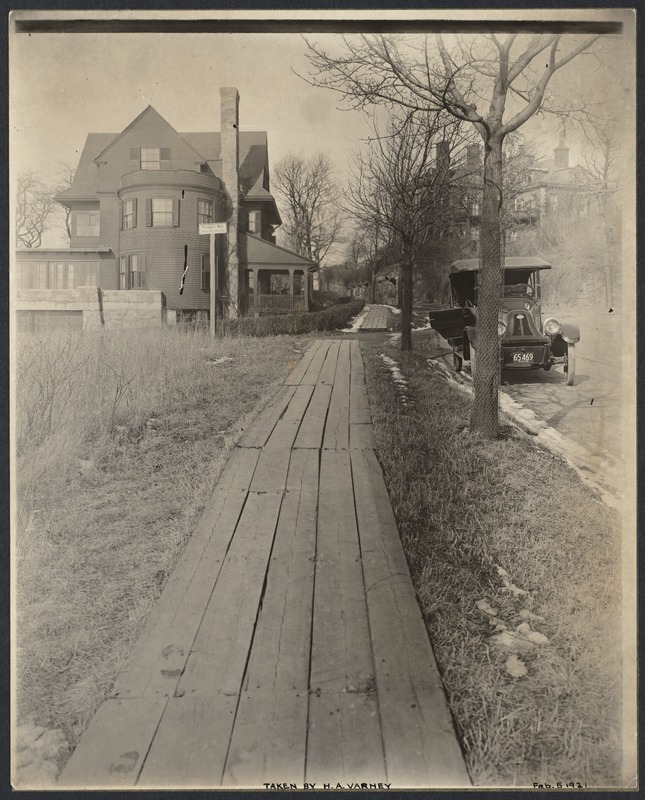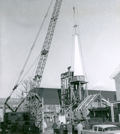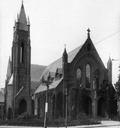 |
23 Prescott St.
[Source: Brookline Preservation Department]
|
 |
23 Prescott St.
The rear of the house is on the left. To the left is 9 Prescott St., still standing. In the distance on the right is the rear of 132 Carlton St., still standing.
[Source: Brookline Preservation Department]
|
 |
Lancaster Terrace, February 5, 1921
138 Lancaster Terrace is on the left, the rear of 232 Summit Ave. is on the right, both still standing. Photo by Henry A. Varney, Brookline town engineer, whose car is in the photo.
[Source: Digital Commonwealth]
|
 |
Leyden Congregational Church
, 1841 Beacon St.
Built in 1910
|
 |
St. Mark's Church, Park St.
Park St. in front, Vernon St on the right
|
 |
St. Mark's Church, Park St.
[Source: Digital Commonwealth]
|
 |
Baptist Church, Beacon & Park Sts.
In early 1908, the church moved here from its prior location at the corner of Pierce and Harvard. The Presbyterian Church then relocated from its Prospect St. location to the old Baptist Church building in early 1910.
|
 |
All Saint's Church
Beacon St. and Dean Rd.
|
 |
Baptist Church, 1876
Harvard St., corner Pierce St. From the series of photographs of the Village by Richard Hills.
[Source: Brookline Preservation Department]
|
 |
Rebuilding of the First Presbyterian Church, 1961
Holden St. The steeple and underlying structure are being raised for the new building after fire destroyed the church building on the corner of Harvard and Pierce.
[Source: Brookline Preservation Department]
|
 |
St. Mary of the Assumption Church, Built 1886
Corner of Harvard St. and Linden St. Built to serve newly immigrated Irish Catholics.
|
 |
Temple Ohabei Shalom, 1928
Photograph by the Boston Herald newspaper on November 25, 1928 for a story on the upcoming dedication ceremony on December 12. At the time, the congregation was already the oldest in Boston at 86 years old. The still-undeveloped land on Kent St., part of a large estate, can be glimpsed on the left. Beacon St. is in the foreground.
|
 |
St. Aidan's Church
Freeman St. , built 1912
|
 |
Harvard Congregational Church; Erected 1873
Corner Marion St. and Harvard St.
|
 |
Harvard Congregational Church, Harvard St. South of Coolidge Corner
|
 |
Church of St. Lawrence, 774 Boylston St.
Second Roman Catholic church to open (1897) in Brookline. Boylston St. west of Chestnut Hill Ave.
|
 |
St. Lawrence Catholic Church, 1907
774 Boylston St. Just west of Chestnut Hill Ave.
|
 |
Chestnut Hill High Service Pumping Station, 1898
Looking from Beacon St. toward Brookline. The house and barn of Michael McGrady on Reservoir Lane are visible on the left.
[Source: Digital Commonwealth]
|
 |
Reservoir Lane, 1898
[Reservoir Lane View 1] This view is taken roughly from the railroad tracks (today’s “D” line) behind the Metropolitan Water Works Pumping Station and is the first in line of a sequence of photos of Reservoir Lane as it goes southward to Boylston St.
In the center rear is the first house built by Michael McGrady on his property of 8 acres. He purchased the Learned family land in 1865 and built the house around that time, it was torn down in 1901. Circa 1889-1890 he built the house in the foreground and a barn that is off screen to the left. Both are still standing at 57 Reservoir Lane. After McGrady’s death in 1912, Ernest Dane bought the land and raised vegetables for his large Chestnut Hill estate at 400 Heath Street.
Reservoir Lane is one of the earliest roads in Brookline and was originally a section in the trail used by Native Americans to travel from Roxbury to Nonantum Hill in Newton. In 1905, the lane became today’s Reservoir Road, a new section was added on the north end connecting to Middlesex Rd., and only a small length of the lane remains by Middlesex Rd.
In 1892, author Bradford Kingman described the lane as “one of the wildest and most picturesque spots, and the land thereabouts such as anyone who had never explored would hardly suppose could be found within the limits of such a town as Brookline, and so near to Boston. The present lane is narrow, rocky, winding, steep, up hill and down vale, bordered with briars and gay with wild flowers, or attractive with berries in their season.”
[Source: Digital Commonwealth]
|
 |
Reservoir Lane, 1898
[Reservoir Lane View 2] On the left is the first house of Michael McGrady soon to be torn down in 1901. On the right Webber’s Waste Weir, located on top of the aqueduct that is flowing alongside Reservoir Lane to the Brookline Reservoir on Boylston St. It can be viewed today from Reservoir Road.
Reservoir Lane is one of the earliest roads in Brookline and was originally a section in the trail used by Native Americans to travel from Roxbury to Nonantum Hill in Newton. In 1905, the lane became today’s Reservoir Road, a new section was added on the north end connecting to Middlesex Rd., and only a small length of the lane remains by Middlesex Rd.
In 1892, author Bradford Kingman described the lane as “one of the wildest and most picturesque spots, and the land thereabouts such as anyone who had never explored would hardly suppose could be found within the limits of such a town as Brookline, and so near to Boston. The present lane is narrow, rocky, winding, steep, up hill and down vale, bordered with briars and gay with wild flowers, or attractive with berries in their season.”
[Source: Digital Commonwealth]
|